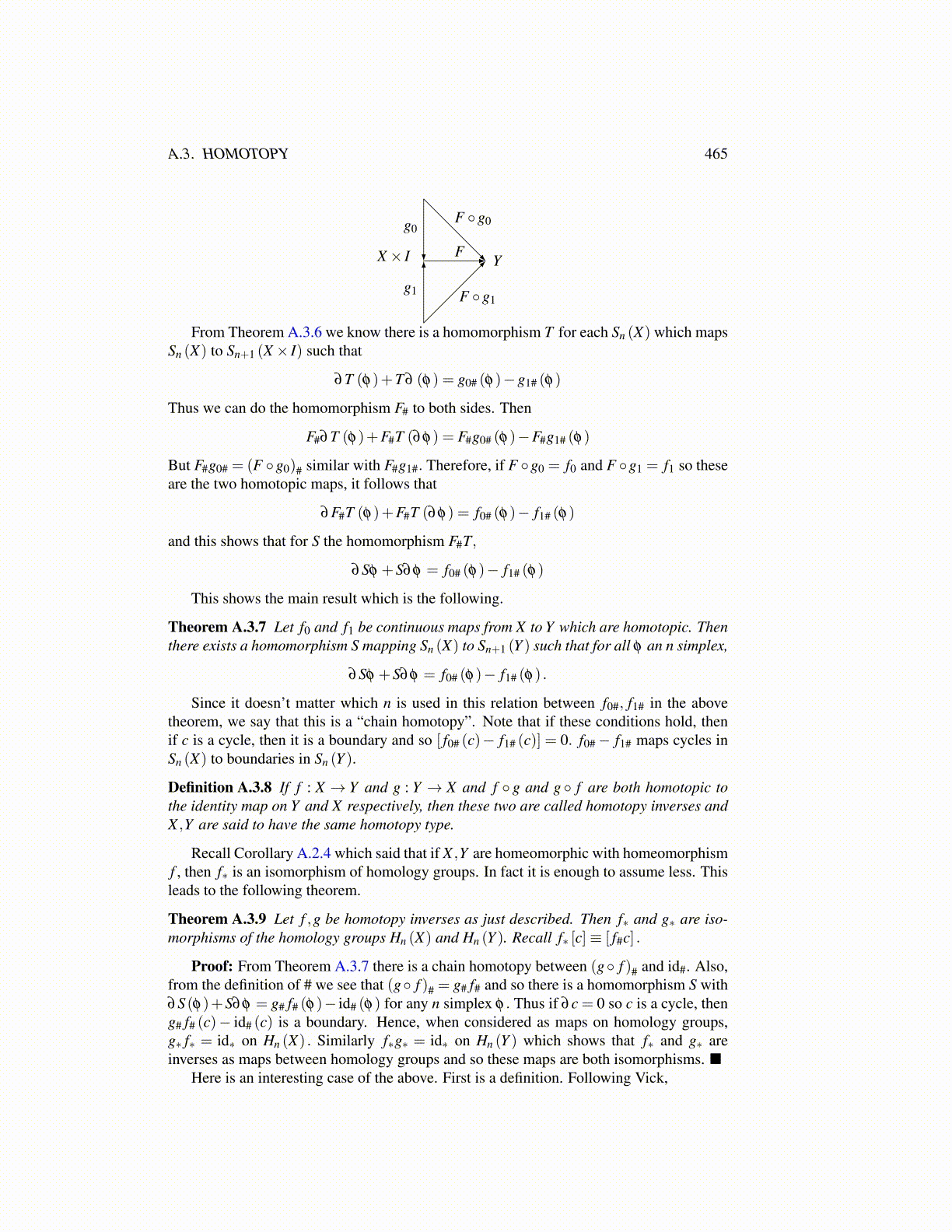
A.3. HOMOTOPY 465
X× I Y
F ◦g0
F ◦g1
g0
g1
F
From Theorem A.3.6 we know there is a homomorphism T for each Sn (X) which mapsSn (X) to Sn+1 (X× I) such that
∂T (φ)+T ∂ (φ) = g0# (φ)−g1# (φ)
Thus we can do the homomorphism F# to both sides. Then
F#∂T (φ)+F#T (∂φ) = F#g0# (φ)−F#g1# (φ)
But F#g0# = (F ◦g0)# similar with F#g1#. Therefore, if F ◦g0 = f0 and F ◦g1 = f1 so theseare the two homotopic maps, it follows that
∂F#T (φ)+F#T (∂φ) = f0# (φ)− f1# (φ)
and this shows that for S the homomorphism F#T,
∂Sφ +S∂φ = f0# (φ)− f1# (φ)
This shows the main result which is the following.
Theorem A.3.7 Let f0 and f1 be continuous maps from X to Y which are homotopic. Thenthere exists a homomorphism S mapping Sn (X) to Sn+1 (Y ) such that for all φ an n simplex,
∂Sφ +S∂φ = f0# (φ)− f1# (φ) .
Since it doesn’t matter which n is used in this relation between f0#, f1# in the abovetheorem, we say that this is a “chain homotopy”. Note that if these conditions hold, thenif c is a cycle, then it is a boundary and so [ f0# (c)− f1# (c)] = 0. f0#− f1# maps cycles inSn (X) to boundaries in Sn (Y ).
Definition A.3.8 If f : X → Y and g : Y → X and f ◦ g and g ◦ f are both homotopic tothe identity map on Y and X respectively, then these two are called homotopy inverses andX ,Y are said to have the same homotopy type.
Recall Corollary A.2.4 which said that if X ,Y are homeomorphic with homeomorphismf , then f∗ is an isomorphism of homology groups. In fact it is enough to assume less. Thisleads to the following theorem.
Theorem A.3.9 Let f ,g be homotopy inverses as just described. Then f∗ and g∗ are iso-morphisms of the homology groups Hn (X) and Hn (Y ). Recall f∗ [c]≡ [ f#c] .
Proof: From Theorem A.3.7 there is a chain homotopy between (g◦ f )# and id#. Also,from the definition of # we see that (g◦ f )# = g# f# and so there is a homomorphism S with∂S (φ)+S∂φ = g# f# (φ)− id# (φ) for any n simplex φ . Thus if ∂c = 0 so c is a cycle, theng# f# (c)− id# (c) is a boundary. Hence, when considered as maps on homology groups,g∗ f∗ = id∗ on Hn (X) . Similarly f∗g∗ = id∗ on Hn (Y ) which shows that f∗ and g∗ areinverses as maps between homology groups and so these maps are both isomorphisms. ■
Here is an interesting case of the above. First is a definition. Following Vick,